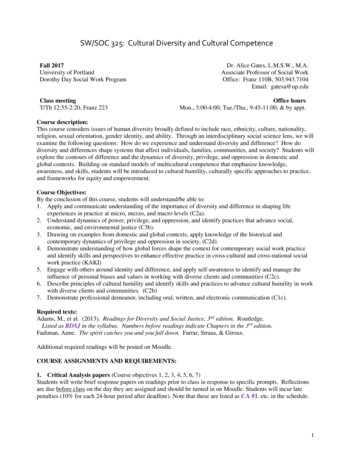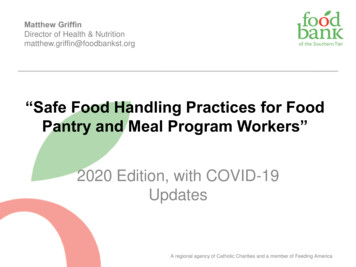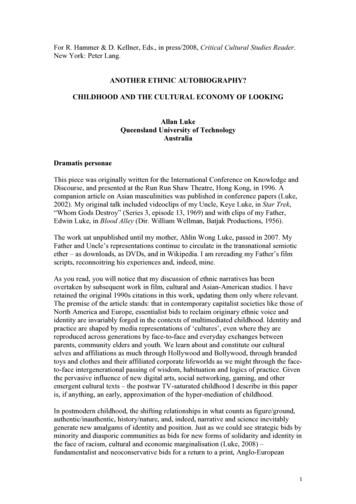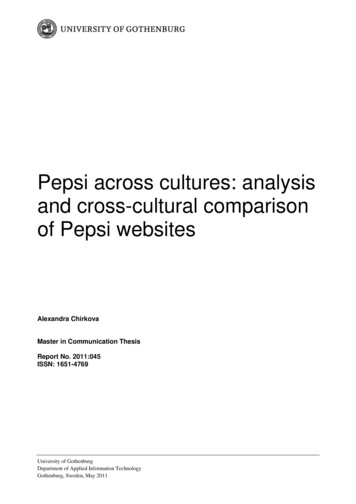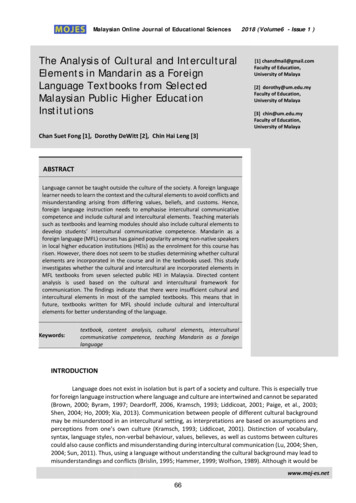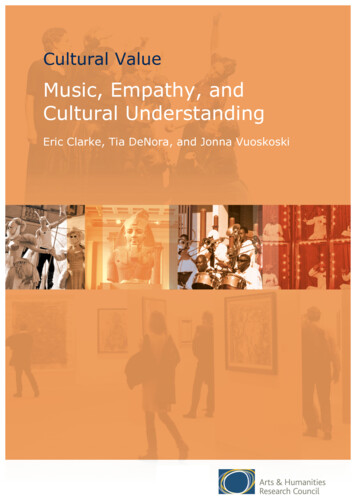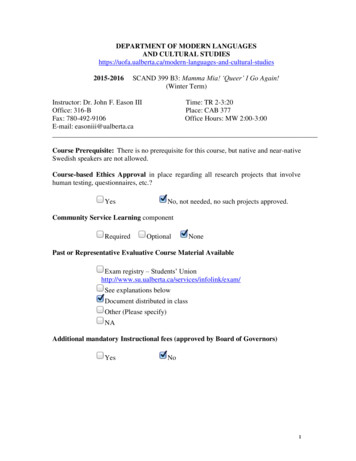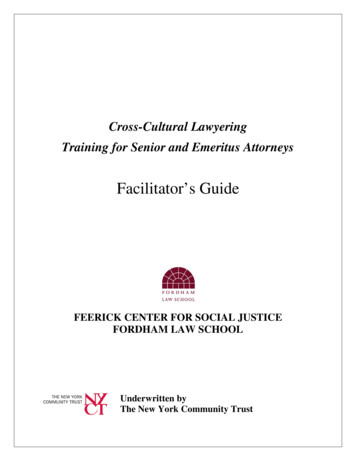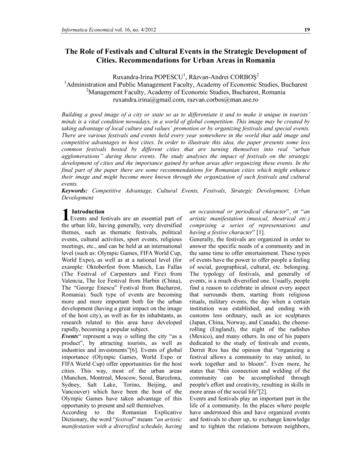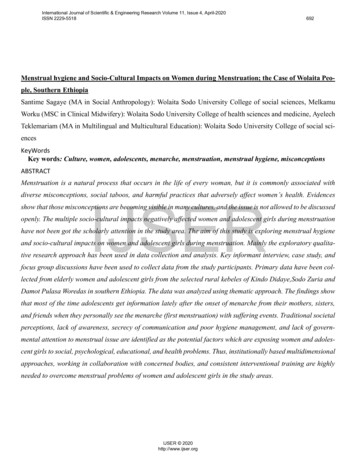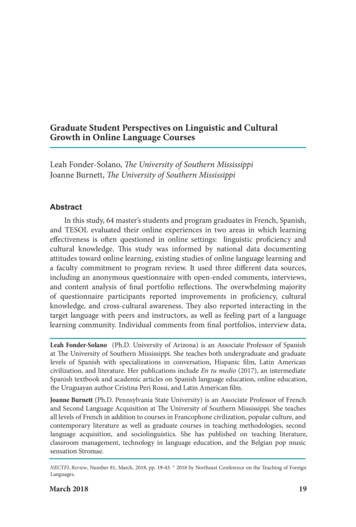
Transcription
Food and cultural practices of the Indiancommunity in Australia – a community resourceFood is central to the cultural and religious practices of most communities. For this reason, understanding and appreciatingthe food and food practices of another culture is part of building your own cultural competence. What people eat is alsoimportant to their long-term health. When people migrate to Australia, changes to the food they eat and reductions inphysical activity often result in poorer health in the long term.Common health problems include nutrition-related chronicdiseases like type 2 diabetes and heart disease.SrinagarJammuChandigarhShimlaDehradunNEW patnamPanaiBengaluruChennaiThiruvananthapuramThis resource provides information about the food and food practices of Indian people settled in Brisbane (Australia).It also provides general information on traditional greetings and etiquette, a general background on their country andtheir health profile in Australia. For readers who are involved in nutrition education, there is also a section on culturallyappropriate ways to approach this.1. Traditional greetings and etiquette I t is generally more appropriate to greet community members in English. Ask permission before using a person’s first name. Don’t shake hands with women, especially if you are a man. Stand to welcome older people as a sign of respect. Be friendly and smile throughout the interview. At the outset of your meeting, tell community members what the consultation is for and why the information they provide needsto be accurate. If you visit someone’s home and are offered food, it is polite to eat it.2. Cultural information and migration historyEthnicityThe Indian community is mostly Indo-Aryan and Dravidian in origin. Cultural practices vary in India withgeographical region and religion. India can be broadly divided into four major regions (North, South, East andWest), each with its own distinctive language, customs and food practices.ReligionHinduism is the predominant religion practiced in India (80%), followed by Islam (13.4%), Christianity (2.3%), Sikhism(1.9%), Buddhism (0.8%) and Jainism (0.4%).1 The followers of these religions observe different dietary laws for fastingand feasting.This information is to be used as a guide and is not intended to describe all members of the community. There will be cultural differences between people belonging to different regions, religionsand social groups, as well as between individuals within any culture.
2. Cultural information and migration history – continuedLanguageOver 400 official languages have been recorded in India2, but 41% of the population speaks Hindi3 (the officiallanguage in government documents), while English is the secondary official language. Most states have their ownlanguage, e.g. Tamil, Bengali, Malayalam and Telegu.Migration historyIndian migrants, as well as migrating from India, also migrate from Pakistan, Bangladesh and Sri Lanka. There arelarge Indian communities in Fiji, Malaysia, Singapore and the United Kingdom. Migration often separates familymembers. In the past, older parents were sponsored to join their children in migrating to Australia; however, recentchanges to migration laws have made this practice prohibitively expensive.Gender rolesBoth marriage partners are expected to work; however, in the home women are responsible for a number ofhousehold duties.Household sizeThe size of households in India varies from three to five and may include extended family.4 In Australia in 2011, 78%of Indian migrants lived in households of two to four persons, with very few living in households of six of morepersons (4%).5Population inAustraliaAll states and territories are home to the Indian-born population in Australia. The largest numbers live in New SouthWales and Victoria. There are approximately 30,300 Indian-born people in Queensland, with largest numbers in thegreater Brisbane area.63. Health profile in AustraliaLife expectancyIn Australia, the Indian-born population has higher rates of mortality and hospitalisation from diabetes and relatedcomplications.7 This is partly due to changes in food habits associated with migration and a more sedentarylifestyle.New arrivals M ost migrants from India are healthy on arrival. It is important to stress the susceptibility to central obesity andthe need to maintain a healthy weight. Vitamin D deficiency may be an issue because traditionally Indian women avoid the sun, use umbrellas for shadeand wear clothes that cover most of the body. This is done for socio-cultural and religious purposes. 8 Iron-deficiency anaemia is endemic for children, female adolescents and pregnant women in India. Poverty andstrict vegetarianism, defined as a diet without any meat, fish or eggs, as well as minimal and inconsistent ironfortification of foods in India, are considered major causes.9Chronic diseaseSome of the important health problems faced by Indian immigrants include chronic diseases such as diabetes,hypertension, cardiovascular disease and complications arising from any of these conditions. There is evidencefrom countries with a long history of migration from India (the UK, US and Canada) that the prevalence of type 2diabetes and heart disease is much higher among South Asians (including Indians) than the general population.10-14This could partly be due to childhood malnutrition as well as genetic risk factors.15 Other studies have shown thatthis risk continues over generations.16Oral healthAlert new arrivals of the need for regular checkups. In general, preventative health is not seen as a priority in India,so people tend to wait until they have an issue before seeing a dentist.Socialdeterminants ofhealth and otherinfluencesIndian migrants have entered Australia via a number of different non-humanitarian schemes. Government policieshave encouraged many people to move to Australia from lower socio-economic backgrounds to receive trainingand subsequent employment in specific employment areas (e.g. aged care, cooking and hairdressing). This is notapplicable to all migrants. There is a high proportion of highly qualified Indian migrants living in Australia.Most families place a high value on education, resulting in upward social mobility in Australia.2Food and cultural practices of the Indian community in Australia – a community resourceThis information is to be used as a guide and is not intended to describe all members of the community. There will be cultural differences between people belonging to different regions, religionsand social groups, as well as between individuals within any culture.
4. Traditional food and food practicesTraditional food choices usually depend on regional preferences. About 30% of Indians are vegetarian.9 N orth: Punjabi cuisine typically represents foods of all the states north and west of Maharashtra. This is the most popular food in restaurantsand is synonymous with Indian food globally: predominantly wheat-based breads (roti and naan), basmati rice for special pulaos (rice-baseddishes that include vegetables and/or meat), and legumes such as chickpeas and kidney beans. Dairy products such as paneer and yoghurt,butter and ghee are used extensively. South: This is primarily a rice-eating region. A variety of dhals (thick soup made from lentils or other legumes) and vegetables are popular.Both rice and dhals are served in a number of ways: pounded, ground, fermented, boiled and steamed. Coconut is used in cooking. Dairy ismainly in the form of plain, unsweetened yoghurt.Common aspects C hicken and goat meat are popular all over India, depending on affordability. Beef is consumed only by Christians and Muslims, and porkby Christians only. Meat is not usually eaten every day of the week. Fish is popular in coastal areas. Fruits are usually consumed fresh. Desserts made from milk, sugar, rice or dhals, using ghee, nuts and spices such as cardamom, are common only on special occasions. Ghee may be served with rice as a flavour enhancer. Sesame, peanut and other vegetable oils are generally used in cooking. Pickles andpappadams (crispy wafers) are often used as accompaniments. Water is served with meals. ‘Milky’ coffee and tea with sugar are also consumed. Spices used include coriander seeds, asafoetida, cumin seeds, fenugreek, ginger, pepper, chilli, garlic, turmeric, saffron and cardamom.Religion and religious festivals in all groups in India play a major role in food avoidances or inclusions.Traditional meals and snacksBreakfastCereal, toast, rice-based traditional dishes, roti and juice are consumed for breakfast.Main and othermealsRice or roti (dry, pan-fried flat bread) with dhals, chicken or fish curry (or vegetarian meals for some communities)are eaten most days.Fruit andvegetablesVegetables include okra, a variety of gourds, eggplant, snake beans, various leaves (similar to spinach), chocos,tapioca/cassava, drumsticks (long beans and leaves from a tree grown in the South of India), green adzuki beans inthe pod and herbs (e.g. curry leaves). A comprehensive list of vegetables can be found here.Fruits include mangoes, tamarinds, bananas, papayas, sapodillas and imported temperate fruits such as apples andgrapes.SnacksIn India, people are likely to have a savoury fried snack, such as a samosa, with a hot drink. Peanuts, cashews andcorn chips are also popular. Other common snacks are listed below:ChipsBanana, tapioca, jackfruit and potato (thin slices, deep fried)Sev, Chewda, BhujiaAll deep-fried snacks (chickpea flour base with spices; different shapes and thicknesses)MurukkuDeep-fried savoury snack made from rice, lentils and spicesVadaDeep-fried savoury snack made from lentils and spicesMixtureDeep-fried chickpea flour with nutsSamosasDeep-fried pastry filled with potatoes, or other vegetables or meatBondaDeep-fried potatoes in chickpea batterPakodaDeep-fried onions or cashew nuts with chickpea batterFood and cultural practices of the Indian community in Australia – a community resource3This information is to be used as a guide and is not intended to describe all members of the community. There will be cultural differences between people belonging to different regions, religionsand social groups, as well as between individuals within any culture.
4. Traditional food and food practices – continuedTakeawaysThese are uncommon. Families occasionally eat out at fast food outlets, usually catering to children’s requests, or atIndian restaurants.BeveragesWater, coffee, tea and juice.Celebration foodsand religious foodpracticesCakes and sweets are generally not eaten regularly. When eaten, they are usually purchased unless made athome especially for a festival. Many sweets are milk/milk powder based. For an exhaustive list with pictures andingredients, click here.Practices vary according to region and occasion. Biryani (made from meat or vegetables and rice) is a popularfestive food eaten by all. Most Hindus will avoid any non-vegetarian food at festivals. Meat and fish are alsoavoided on certain days of the week as part of religious observances.Fasting is important to almost all religious traditions. For Hindus, there are differences in how often this is practicedby individuals and how fasting is defined (e.g. it may just entail avoiding solid foods). In the Hindu tradition, peoplechoose to fast as part of their worship of many different deities for various purposes, e.g. for married people toensure a happy married life, and for unmarried girls to find an ideal husband.Common traditional foodsIndian breadsRoti/chapatti, made from whole wheatflour (atta) and waterRoti are cooked on a dry griddle. They are commonly eaten atbreakfast and main meals. Wheat flour is often purchased in5 or 10 kg bags.Puri, made from wheat flour, water, gheeand oilPuri are deep fried and served with potato masala (curry madewith potatoes) or chole (chickpea curry) and/or chutney.Paratha, made from whole wheat flour(atta), oil, butter/oil for frying and saltParatha are made from layers of dough brushed with ghee orcooking oil and cooked on a griddle.Dosa, made from rice, lentils, salt and asmall amount of oilDosa is crepe-like bread that is dry fried and served with avariety of items (curry, dhal, chutney, etc.)Naan, made from white flour, yeast, milk,egg, yoghurt, oil and saltDough is baked onto the side of a hot, dome-shaped clay ovenreferred to as a tandoor.4Food and cultural practices of the Indian community in Australia – a community resourceThis information is to be used as a guide and is not intended to describe all members of the community. There will be cultural differences between people belonging to different regions, religionsand social groups, as well as between individuals within any culture.
Common traditional foods– continuedIndian ricesRice types vary greatly in their glycaemic indices and amountsof fibre; e.g. red rice is eaten by people from Southern Indiaand is higher in fibre and protein than white rice. In Australia,basmati rice is used quite extensively. Jasmine rice is seldomconsumed. Rice is often purchased in bulk from specialty Indianfood stores.5. Food habits in AustraliaFood practicesMeal patterns: Three meals a day are eaten, with lunch and dinner being similar in composition.Eating style: Food is usually eaten with the fingers of the right hand; cutlery is rarely used except to serve food.Stainless steel plates and tumblers may be used. In traditional households, elderly family members and men areserved before the rest of the family. In more modern households, the family eats together.Adaptations todiet in AustraliaSubstitute foods: New Indian migrants may be reluctant to adopt new vegetables. Many grow their owntraditional vegetables and fruit in Australia.Because of the wide range of Indian products
Food and cultural practices of the Indian community in Australia – a community resource Food is central to the cultural and religious practices of most communities. For this reason, understanding and appreciating the food and food practices of another culture is part of building your own cultural competence. What people eat is also important to their long-term health. When people migrate to .File Size: 1MBPage Count: 8
